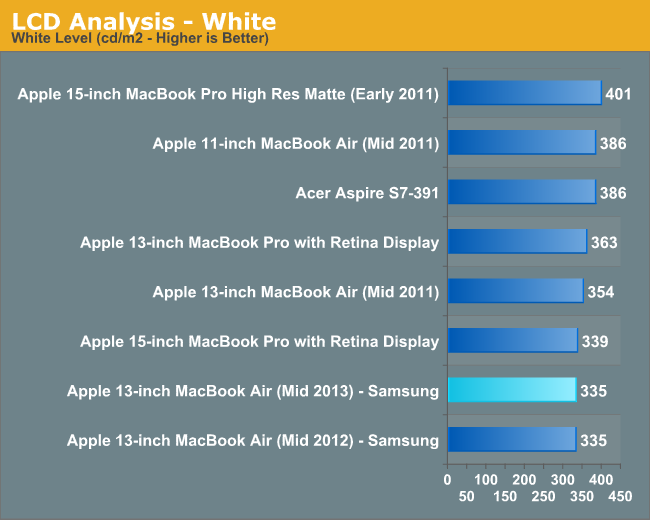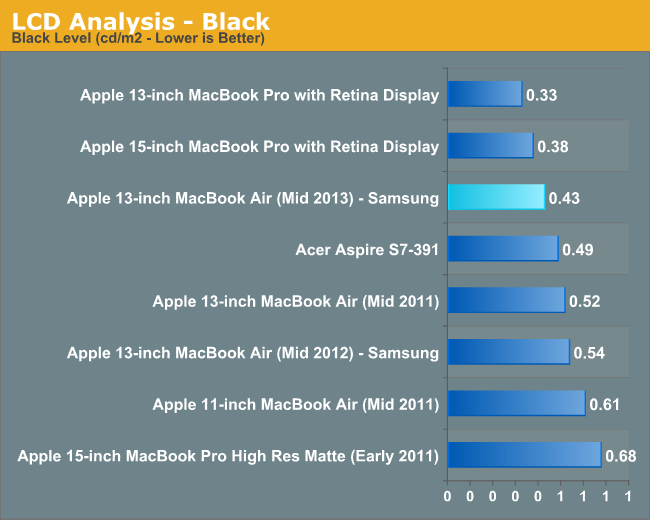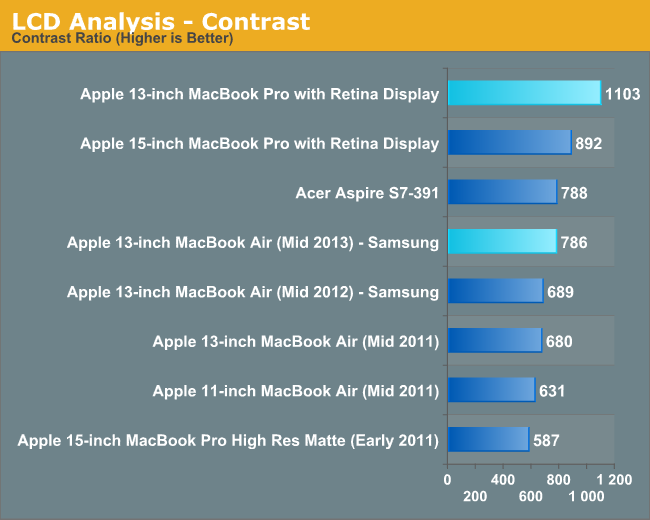The 2013 MacBook Air Review (13-inch)
by Anand Lal Shimpi on June 24, 2013 12:01 AM ESTDisplay
When I reviewed the 13-inch MacBook Pro with Retina Display, I viewed it as the true Retina MacBook Air that everyone was waiting for. With modest increases in thickness and weight, the rMBP13 gave you a much better screen and a larger battery to drive it. Apple’s lineup made sense.
After being in Taiwan earlier this month and checking out all of the 13.3-inch 2560 x 1440 displays being used on notebooks similar in size to the 13-inch MBA, I was beginning to reconsider my position.
To hit an aggressive schedule, you have to mitigate risk. In the case of the 2013 MBAs, Apple kept the chassis spec unchanged in order to do just that. As a result, the displays too, remained unchanged. We’re talking about TN panels (admittedly higher quality than most) and traditional pixel densities. Compared to the Retina Displays deployed across the rest of Apple’s product lines, these panels just aren’t as good. Compared to what you typically find elsewhere, they’re still among the best.

There are two aspects to deploying a Retina Display in a MacBook Air that are worth discussing. The first is power consumption. Greater pixel density requires a more powerful backlight to drive the panel at the same brightness, which in turn reduces battery life. Apple’s solution is to deploy Retina Displays on products it can outfit with a sufficiently large battery. I’d argue that given the battery life of the 2013 MBAs, Apple could move to a Retina Display and still deliver reasonable battery life - but it would be a regression.
The second thing to consider is price. I don’t know just how much more a Retina Display would add to the cost of a MacBook Air, but it’s clear it would be non-negligible.
There’s no real solution to the first problem, but the second one should be less of an issue as panel prices come down. I don’t know where Apple will eventually land on all of this, but today what happens is we get a well defined separation between MacBook Air and MacBook Pro with Retina Display.
Professional users who need greater color accuracy and/or additional desktop resolution really should go for the MacBook Pro with Retina Display. If you don’t need either, the MacBook Air will suffice.
In practice, the MBA’s display isn’t bad by any means. I’ve been staring at it non-stop since WWDC and don’t mind using it at all. The biggest visual issue for me is actually the shifting contrast at off-center vertical angles. It’s not a problem once you properly adjust the display angle but it’s something you don’t have to deal with on the rMBPs. When I'm not in crazy work mode, the lack of resolution isn't a huge deal - but when putting together big articles like this one, I find myself missing the rMBP quite a bit. I guess that's why the rMBP has Pro in the name.



My review sample featured a Samsung panel (LSN133BT01A02), although I’m sure the usual panel lottery is in full effect this generation as it has been in the past. Brightness and contrast are both comparable to what we had last generation (my Samsung panel this year was a bit better than last year's). The brightness/contrast results are very comparable to Acer's 1080p S7, just to show you how far Ultrabooks have come.
I ran the 2013 MBA through Chris Heinonen’s new display workflow using CalMAN to give you an idea of color accuracy vs. the rMBP:



| CalMAN Display Comparison | ||||||||
| Apple iPad (3rd gen) | Apple iPhone 5 | 13-inch rMBP (uncalibrated) | 13-inch 2013 MBA (uncalibrated) | Google Chromebook Pixel | ||||
| Grayscale 200 nits Avg dE2000 | 3.7333 | 3.564 | 1.7825 | 3.348 | 7.132 | |||
| CCT Avg (K) | 6857K | 6925K | 6632K | 6809K | 6442K | |||
| Saturation Sweep Avg dE2000 | 3.193 | 3.591 | 2.1663 | 5.3608 | 7.0927 | |||
| GMB Colorchecker Avg dE2000 | 3.0698 | 4.747 | 2.4521 | 3.9883 | 5.7664 | |||
The 13-inch MacBook Air isn’t bad, but Apple’s Retina Display is just better.













233 Comments
View All Comments
abazigal - Wednesday, June 26, 2013 - link
It's ultimately an issue of tradeoffs. Long battery life vs High quality display. I think between the 2, more people will opt for the longer battery life (considering it is an air you are getting after all).xTRICKYxx - Monday, June 24, 2013 - link
It shoulxTRICKYxx - Monday, June 24, 2013 - link
It should be 1680x1050KPOM - Thursday, June 27, 2013 - link
Scaling is an issue. Apple won't change the resolution until it can go "Retina" and quadruple it. OS X wasn't designed to scale at 150% like Windows Metro. No sense making a halfway move when the output won't look good. That's probably why Windows 7 notebooks stayed at 1366x768 for so long. Windows 7 itself could scale but most Desktop applications can't.spronkey - Monday, June 24, 2013 - link
To be honest, unless you go to *really* high res (i.e. "retina"), 1600x900 isn't really a large improvement on 1440x900, and anything higher than that becomes a little difficult to read without scaling, and ends up looking nasty. I personally think 1440x900 is a nice Mid-DPI resolution for these 13" machines.darwinosx - Monday, June 24, 2013 - link
It is for pretty much everyone as unless you go all the way to retina you get tidy text and icons.axien86 - Monday, June 24, 2013 - link
Not only that, but reading that Anand got the objectively better Samsung display instead of the LG display by luck of the "lottery" is one lottery that many buyers do not win.
Secondly, Anand describes Haswell THERMAL LIMITING and how it reduces performance, but how about simple measurements of important factors like CPU, GPU, keyboard and chassis temperature under load?
At other Mac forums, users with the new Macbook Air 2013 are finding many 3D games along with Flash/HD Youtube causes loud and irritating fan noise along with rapid dramatic rise in temperature.
No review of a ultralight laptop is complete without a complete noise and temperature analysis.
Synaesthesia - Monday, June 24, 2013 - link
Anand's reviews are the best. The 2012 and previous models had no issues with fan noise and heat generation, nor thermal limiting. The 2013 models with Haswell have much lower power consumption and heat generation will necessarily be much lower, so I'm sure it's great too, and that thermal limiting doesn't kick in at all.Synaesthesia - Monday, June 24, 2013 - link
Quoted from article: "For example, the fan was never audible on the 2013 MBA while running this test compared to running at a very noticeable volume on the 2012 Core i7 model. The same goes for temperatures. The i7 2012 model tends to run about 5% warmer along the bottom of the chassis compared to the 2013 i5."ddriver - Monday, June 24, 2013 - link
They are far too biased, but then again, so are you probably, if you find them "the best" you simply are on the same direction of bias.